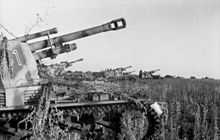Wespe
| Wespe | |
|---|---|
|
Wespe at the Deutsches Panzermuseum in Munster, Germany | |
| Type | Self-propelled artillery |
| Place of origin | Nazi Germany |
| Service history | |
| In service | 1943 - 1945 |
| Used by | Nazi Germany |
| Wars | World War II |
| Production history | |
| Designer | Alkett |
| Designed | 1942 |
| Manufacturer | Famo-Ursus |
| Produced | 1943 - 1944 |
| Number built | 676 |
| Variants | ammunition carrier |
| Specifications | |
| Weight | 11 tonnes (24,250 lb) |
| Length | 4.81 m (15 ft 9 in) |
| Width | 2.28 m (7 ft 6 in) |
| Height | 2.3 m (7 ft 7 in) |
| Crew | 5 (commander, driver, three gunners) |
|
| |
| Armor | 5 - 30 mm (.19 - 1.18 in) |
Main armament |
1x 10.5 cm leFH 18/2 L/28 with 40 rounds |
| Engine |
6-cyl petrol Maybach HL 62 TR 140 PS (138 hp, 103 kW) |
| Power/weight | 12.7 PS/tonne |
| Suspension | leaf spring |
Operational range | 220 km (137 mi) |
| Speed | 40 km/h (25 mph) |
The Sd. Kfz. 124 Wespe (German for "wasp"), also known as Leichte Feldhaubitze 18/2 auf Fahrgestell Panzerkampfwagen II (Sf.) ("Light field howitzer 18 on Panzer II chassis (self-propelled)"), was a German self-propelled artillery vehicle developed and used during the Second World War. It was based on a modified Panzer II chassis.
Development
In 1940, during the Battle of France, it was apparent that the intermediate tank of the German forces, the Panzer II, was unsuitable as a main battle tank. Though mechanically sound, it was both under-gunned and under-armoured. The chassis, however, proved servicable for providing mobility to the 10.5 cm field howitzer. Existing chassis were converted to self-propelled artillery vehicles, just as had been done with the Marder II which was a conversion designed to provide mobility to the PaK 40/7.5 cm anti-tank gun.
The design for the Wespe was produced by Alkett, and was based on the Panzer II Ausf. F chassis. Alkett had earlier worked with Alfred Becker to convert captured French armoured vehicles into self-propelled artillery carriers. Amongst other modifications to the Panzer II, the engine was moved forward and the chassis was slightly lengthened to gain sufficient space for the rear-mounted 10.5 cm leFH 18 howitzer. The superstructure was lightly armored, with 10 mm armor plate (enough to stop small arms fire) and was open at the top and to the rear. The vehicles were produced by FAMO's Ursus plant in Warsaw.
The Wespe was in production from February 1943 until June 1944 when Soviet forces approached the frontier. By that time, 676 had been produced. An additional 159 were modified to serve as mobile artillery ammunition carriers.[1]
Combat history


The Wespe first saw combat in 1943 on the Eastern Front. It proved very successful, and Hitler ordered all production of Panzer II chassis to be utilized in the production of the Wespe alone, dropping other projects such as the Marder II self-propelled anti-tank gun.
The vehicles were allocated to the armored artillery battalions (Panzerartillerie Abteilungen) of Panzer divisions along with heavier Hummel self-propelled artillery. The Wespe brought greater mobility to the artillery formations of the panzer divisions.
The Wespe was very popular with their crews of due to its reliability and high maneuverability.
Surviving vehicles
- One at the Deutsches Panzermuseum in Munster, Germany
References

- ↑ Thomas L.Jentz, Hillary Louis Doyle: Panzer Tracts No.23 - Panzer Production from 1933 to 1945
External links
| Wikimedia Commons has media related to Wespe. |
- Achtung Panzer!
- AFV Database
- OnWar
- War Gamer
- Surviving Panzer II tanks - A PDF file presenting the Panzer II tanks (PzKpfw. II, Luchs, Wespe, Marder II tanks) still existing in the world
| ||||||||||||||||||||||||||||||||||||||||||||||
